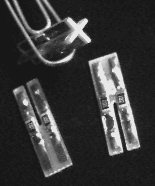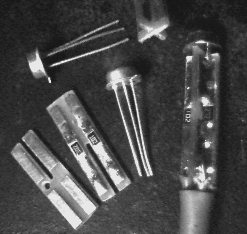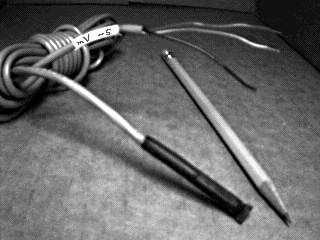Fahrenheit (TF) & Celsius (TC)
Probe Kit
(c) 1998 EME
Systems
<products index>
<home><preassembled
TF & TC data sheet>
In addition to preassembled probes, EME offers parts to construct
probes. The difficulty is that the sensor element must be attached to
the end of the cable along with two resistors in a manner that is
rugged and will withstand both mechanical abuse and immersion in
water and exposure to the elements.
 The
solution we have come up with is a three dimensional circuit board
that has an "X" cross section. The leads of the sensor go into the
arms of the "X" and the 3 or 4 leads of the cable attach at the other
end, with the surface mount resistors and capacitor in the grooves.
The whole assembly is then encapsulated in a Raychem heat shrink
tubing lined with adhesive.
The
solution we have come up with is a three dimensional circuit board
that has an "X" cross section. The leads of the sensor go into the
arms of the "X" and the 3 or 4 leads of the cable attach at the other
end, with the surface mount resistors and capacitor in the grooves.
The whole assembly is then encapsulated in a Raychem heat shrink
tubing lined with adhesive.
@ 1k ,--------,
+ 4-18 volts ---------------/\/\------| |
@ | LM34 |
signal 10mV/degF -----------/\/\------| CAH |
@ 3k | |
common -,----------------------------| |
| @ '--------'
'----------shield-----------
 The
resistor in series with the power supply protects the sensor against
ESD and against polarity reversals. The resistor in the signal line
serves those same purpose, and also isolates the sensor output from
the capacitance of the cable to prevent instability. Observe that the
output resistance of the sensor is 3000 ohms. This may need to be
taken into account in low-impedence systems. Click
here for contsruction details.
The
resistor in series with the power supply protects the sensor against
ESD and against polarity reversals. The resistor in the signal line
serves those same purpose, and also isolates the sensor output from
the capacitance of the cable to prevent instability. Observe that the
output resistance of the sensor is 3000 ohms. This may need to be
taken into account in low-impedence systems. Click
here for contsruction details.
The shield may be necessary only in noisy environments and for
long runs of cable. The sensor only draws about 70 microamps of
current. Therefore ground current errors are minimal. For example, it
takes more than 1000 feet of #22 gage wire to give a ground current
error equivalent to 0.1 degree Farenheit.
The Raychem MVT1 or ES2000 tubing has an adhesive liner that melts
and flows over all the components and fills in the gaps. It also
bonds firmly to PVC cable. It can be pinched shut at the open end to
form a waterproof seal. A standard heat-shrink gun is required. The
tubing then withstands temperatures up to 110 degrees Celsius without
melting.
 Once
the probe is assembled it can be calibrated. The highest grade of
sensors direct from National Semiconductor have an accuracy of +/- 1
degree Fahrenheit, or +/- 0.5 degree Celsius. Lower grades of sensor
may allow +/- 4 degrees F (D grade). The sensor can be calibrated
after assembly at one or two or multiple points. The sensor is quite
linear, and most of the error tends to be in the zero point, not in
the slope. So for <1 degree F error over the range of -17 to +212
Fahrenheit, a single point calibration is all that is required.
We also offer the preassembled probes.
Once
the probe is assembled it can be calibrated. The highest grade of
sensors direct from National Semiconductor have an accuracy of +/- 1
degree Fahrenheit, or +/- 0.5 degree Celsius. Lower grades of sensor
may allow +/- 4 degrees F (D grade). The sensor can be calibrated
after assembly at one or two or multiple points. The sensor is quite
linear, and most of the error tends to be in the zero point, not in
the slope. So for <1 degree F error over the range of -17 to +212
Fahrenheit, a single point calibration is all that is required.
We also offer the preassembled probes.
These same parts in the X3D kit can also be used to mount other
types of sensor to a cable, or to join two cables together with or
without resistors/capacitors/diodes in series with the individual
lines.
<home>
<products index>
<top> <TF
& TC data sheet>  < mailto:info@emesystems.com>
< mailto:info@emesystems.com>
 The
solution we have come up with is a three dimensional circuit board
that has an "X" cross section. The leads of the sensor go into the
arms of the "X" and the 3 or 4 leads of the cable attach at the other
end, with the surface mount resistors and capacitor in the grooves.
The whole assembly is then encapsulated in a Raychem heat shrink
tubing lined with adhesive.
The
solution we have come up with is a three dimensional circuit board
that has an "X" cross section. The leads of the sensor go into the
arms of the "X" and the 3 or 4 leads of the cable attach at the other
end, with the surface mount resistors and capacitor in the grooves.
The whole assembly is then encapsulated in a Raychem heat shrink
tubing lined with adhesive. The
resistor in series with the power supply protects the sensor against
ESD and against polarity reversals. The resistor in the signal line
serves those same purpose, and also isolates the sensor output from
the capacitance of the cable to prevent instability. Observe that the
output resistance of the sensor is 3000 ohms. This may need to be
taken into account in low-impedence systems.
The
resistor in series with the power supply protects the sensor against
ESD and against polarity reversals. The resistor in the signal line
serves those same purpose, and also isolates the sensor output from
the capacitance of the cable to prevent instability. Observe that the
output resistance of the sensor is 3000 ohms. This may need to be
taken into account in low-impedence systems.  Once
the probe is assembled it can be calibrated. The highest grade of
sensors direct from National Semiconductor have an accuracy of +/- 1
degree Fahrenheit, or +/- 0.5 degree Celsius. Lower grades of sensor
may allow +/- 4 degrees F (D grade). The sensor can be calibrated
after assembly at one or two or multiple points. The sensor is quite
linear, and most of the error tends to be in the zero point, not in
the slope. So for <1 degree F error over the range of -17 to +212
Fahrenheit, a single point calibration is all that is required.
Once
the probe is assembled it can be calibrated. The highest grade of
sensors direct from National Semiconductor have an accuracy of +/- 1
degree Fahrenheit, or +/- 0.5 degree Celsius. Lower grades of sensor
may allow +/- 4 degrees F (D grade). The sensor can be calibrated
after assembly at one or two or multiple points. The sensor is quite
linear, and most of the error tends to be in the zero point, not in
the slope. So for <1 degree F error over the range of -17 to +212
Fahrenheit, a single point calibration is all that is required.